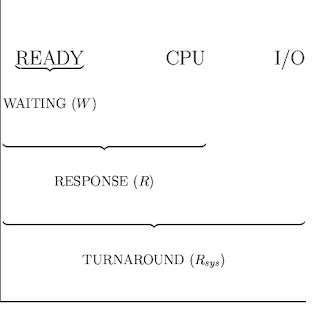
PROCESS SCHEDULING
A process can simply be defined as a program in execution. it can be defined as a program currently making use of the processor at any one time. The diagram below shows the various states of a process:
Ready: This is when the process is ready to be run on the processor.
Running: This is when the process is currently making use of the processor.
Blocked: This is when the process is waiting for an input such as user response or data from another process. A process may be in the blocked state if it needs to access a resource.
Other variations of the above named states are:
Ready Suspend: This is when a process is swapped out of a memory by Memory Management system in order to free memory for other process.
Blocked Suspend: This is when a process is swapped out of memory after incurring an O/I wait
Terminate: This is when a process has finished its run.
Summary
- Only one process at a time is running on the CPU
- Process gives up CPU:
- If it starts waiting for an event
- Otherwise: other processes need fair access
- OS schedules which ready process to run next
- Time slice or quantum for each process
- Scheduling algorithms
- affect performance
SCHEDULING
Scheduling is a key concept in computer multitasking, multiprocessing operating system and real-time operating system designs. Scheduling refers to the way processes are assigned to run on the available CPUs, since there are typically many more processes running than there are available CPUs. This assignment is carried out by software known as a scheduler or dispatcher.
SCHEDULER
The scheduler is concerned mainly with:
CPU utilization - to keep the CPU as busy as possible.
Throughput - number of processes that complete their execution per time unit.
Turnaround - total time between submission of a process and its completion.
Waiting time - amount of time a process has been waiting in the ready queue. Response Time- amount of time it takes from when a request was submitted until the first response is produced.
Fairness - Equal CPU time to each thread.
Types of schedulers
Operating systems may feature up to 3 distinct types of schedulers: a long-term scheduler (also known as an admission scheduler or high-level scheduler), a mid-term or medium-term scheduler and a short-term scheduler (also known as a dispatcher). The names suggest the relative frequency with which these functions are performed.
1. Long-term Scheduler
The long-term, or admission, scheduler decides which jobs or processes are to be admitted to the ready queue; that is, when an attempt is made to execute a program, its admission to the set of currently executing processes is either authorized or delayed by the long-term scheduler. Thus, this scheduler dictates what processes are to run on a system, and the degree of concurrency to be supported at any one time - ie: whether a high or low amount of processes are to be executed concurrently, and how the split between IO intensive and CPU intensive processes is to be handled. In modern OS's, this is used to make sure that real time processes get enough CPU time to finish their tasks. Without proper real time scheduling, modern GUI interfaces would seem sluggish.
2. Mid-term Scheduler
The mid-term scheduler temporarily removes processes from main memory and places them on secondary memory (such as a disk drive) or vice versa. This is commonly referred to as "swapping out" or "swapping in" (also incorrectly as "paging out" or "paging in"). The mid-term scheduler may decide to swap out a process which has not been active for some time, or a process which has a low priority, or a process which is page faulting frequently, or a process which is taking up a large amount of memory in order to free up main memory for other processes, swapping the process back in later when more memory is available, or when the process has been unblocked and is no longer waiting for a resource.
In many systems today (those that support mapping virtual address space to secondary storage other than the swap file), the mid-term scheduler may actually perform the role of the long-term scheduler, by treating binaries as "swapped out processes" upon their execution. In this way, when a segment of the binary is required it can be swapped in on demand, or "lazy loaded".
3. Short-term Scheduler
The short-term scheduler (also known as the CPU scheduler) decides which of the ready, in-memory processes are to be executed (allocated a CPU) next following a clock interrupt, an IO interrupt, an operating system call or another form of signal. Thus the short-term scheduler makes scheduling decisions much more frequently than the long-term or mid-term schedulers - a scheduling decision will at a minimum have to be made after every time slice, and these are very short. This scheduler can be preemptive, implying that it is capable of forcibly removing processes from a CPU when it decides to allocate that CPU to another process, or non-preemptive (also known as "voluntary" or "co-operative"), in which case the scheduler is unable to "force" processes off the CPU.
Dispatcher
Another component involved in the CPU-scheduling function is the dispatcher. The dispatcher is the module that gives control of the CPU to the process selected by the short-term scheduler. This function involves the following:
- Switching context
- Switching to user mode
Jumping to the proper location in the user program to restart that program The dispatcher should be as fast as possible, since it is invoked during every process switch. The time it takes for the dispatcher to stop one process and start another running is known as the dispatch latency.
Scheduling criteria
Different CPU scheduling algorithms have different properties, and the choice of a particular algorithm may favor one class of processes over another. In choosing which algorithm to use in a particular situation, we must consider the properties of the various algorithms. Many criteria have been suggested for comparing CPU scheduling algorithms. Which characteristics are used for comparison can make a substantial difference in which algorithm is judged to be best. The criteria include the following:
1. CPU Utilization. We want to keep the CPU as busy as possible.
2. Throughput. If the CPU is busy executing processes, then work is being done. One measure of work is the number of processes that are completed per time unit, called throughput. For long processes, this rate may be one process per hour; for short transactions, it may be 10 processes per second.
3. Turnaround time. From the point of view of a particular process, the important criterion is how long it takes to execute that process. The interval from the time of submission of a process to the time of completion is the turnaround time. Turnaround time is the sum of the periods spent waiting to get into memory, waiting in the ready queue, executing on the CPU, and doing I/O.
4. Waiting time. The CPU scheduling algorithm does not affect the amount of the time during which a process executes or does I/O; it affects only the amount of time that a process spends waiting in the ready queue. Waiting time is the sum of periods spend waiting in the ready queue.
5. Response time. In an interactive system, turnaround time may not be the best criterion. Often, a process can produce some output fairly early and can continue computing new results while previous results are being output to the user. Thus, another measure is the time from the submission of a request until the first response is produced. This measure, called response time, is the time it takes to start responding, not the time it takes to output the response. The turnaround time is generally limited by the speed of the output device.
It is desirable to maximize CPU utilization and throughput and to minimize turnaround time, waiting time, and response time. In most cases, we optimize the average measure. However, under some circumstances, it is desirable to optimize the minimum or maximum values rather than the average. For example, to guarantee that all users get good service, we may want to minimize the maximum response time. Investigators have suggested that, for interactive systems, it is more important to minimize the variance in the response time than to minimize the average response time. A system with reasonable and predictable response time may be considered more desirable than a system that is faster on the average but is highly variable. However, little work has been done on CPU-scheduling algorithms that minimize variance.
CPU-bound
most of its time doing computation - little I/O
I/O-bound
most of its time doing I/O - little computation
Multilevel scheduling
Classified into different groups :
- foreground (interactive) vs.
- background (batch)
each group has its own ready queue
Preemptive Vs Nonpreemptive Scheduling
The Scheduling algorithms can be divided into two categories with respect to how they deal with clock interrupts.
- Nonpreemptive Scheduling
A scheduling discipline is nonpreemptive if, once a process has been given the CPU, the CPU cannot be taken away from that process.
Following are some characteristics of nonpreemptive scheduling
In nonpreemptive system, short jobs are made to wait by longer jobs but the overall treatment of all processes is fair.
In nonpreemptive system, response times are more predictable because incoming high priority jobs can not displace waiting jobs.
In nonpreemptive scheduling, a schedular executes jobs in the following two situations.
When a process switches from running state to the waiting state.
When a process terminates.
- Preemptive Scheduling
A scheduling discipline is preemptive if, once a process has been given the CPU can taken away.
The strategy of allowing processes that are logically runable to be temporarily suspended is called Preemptive Scheduling and it is contrast to the "run to completion" method.


No comments:
Post a Comment